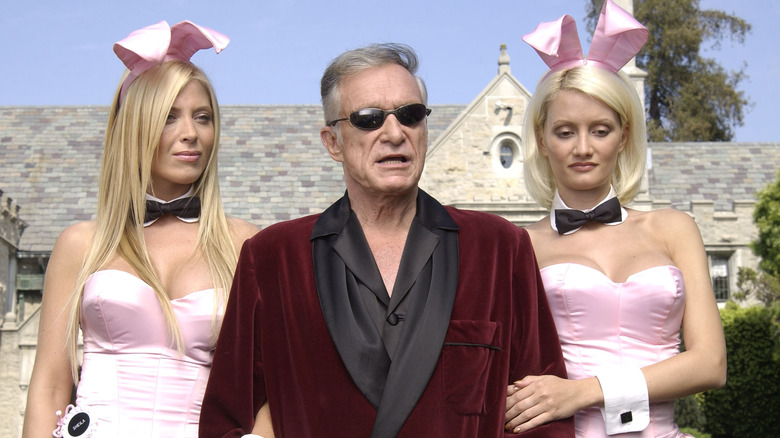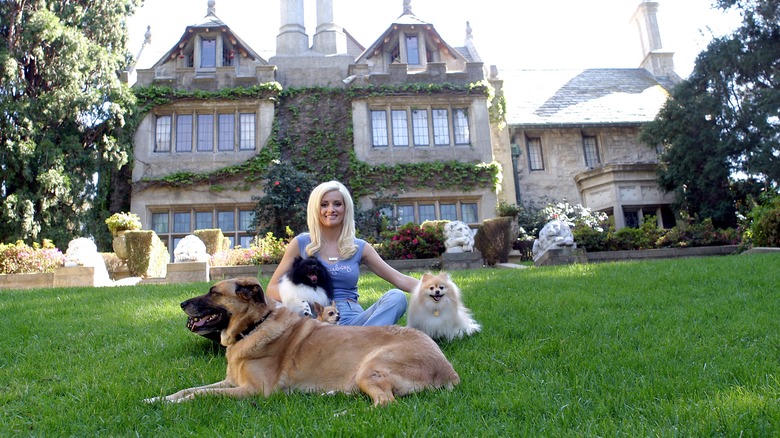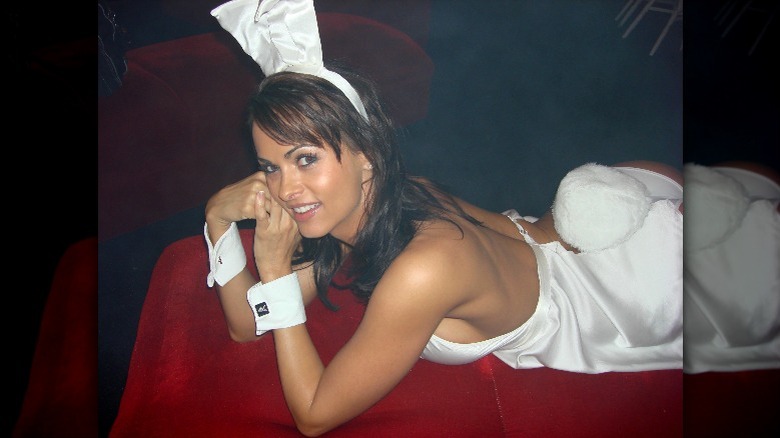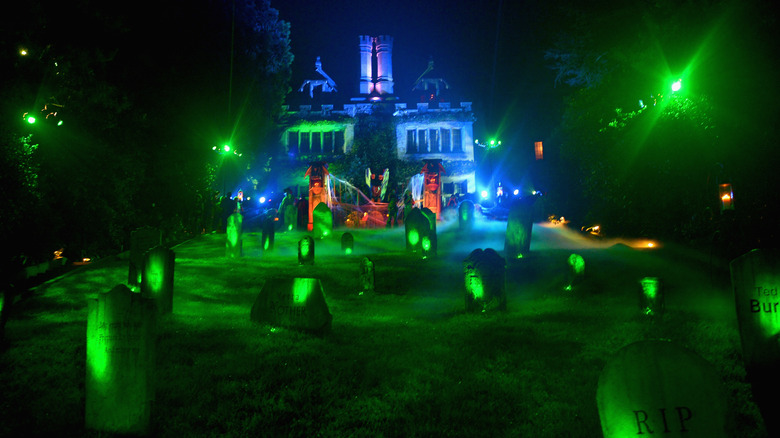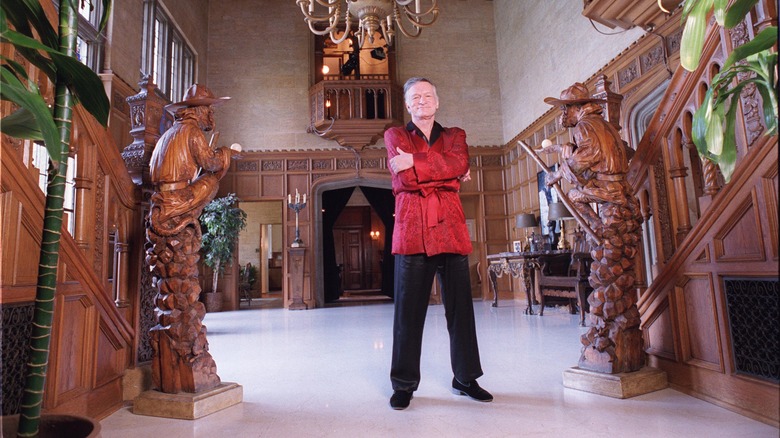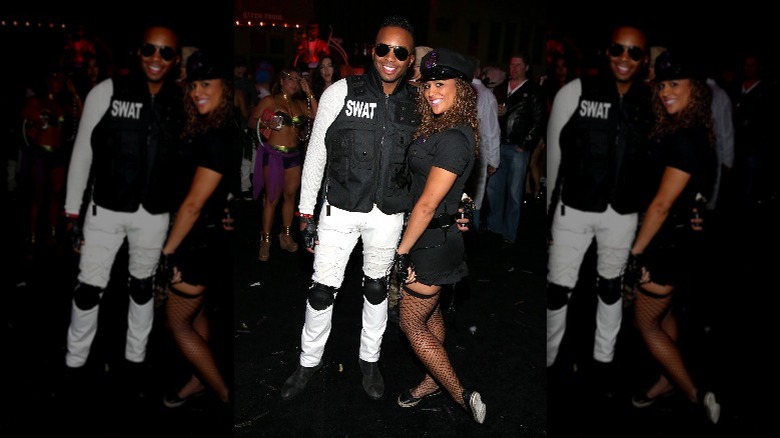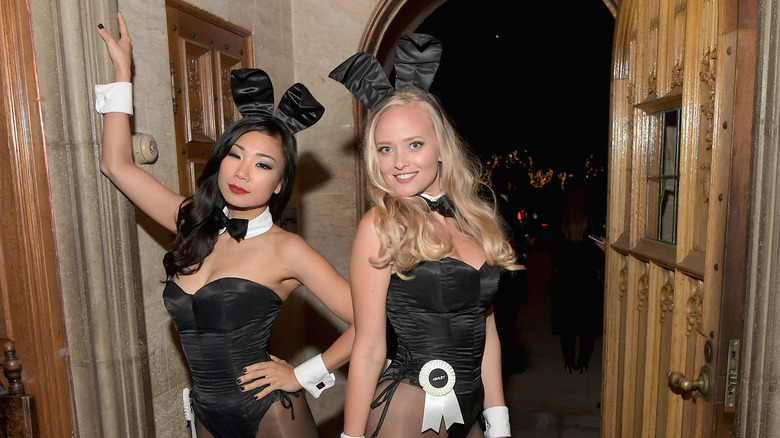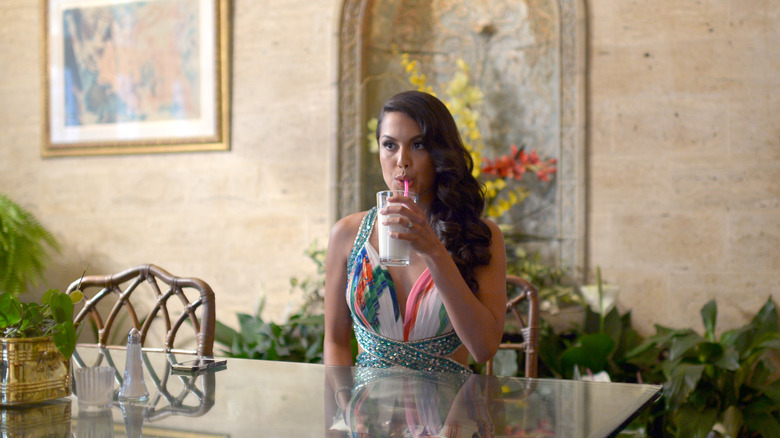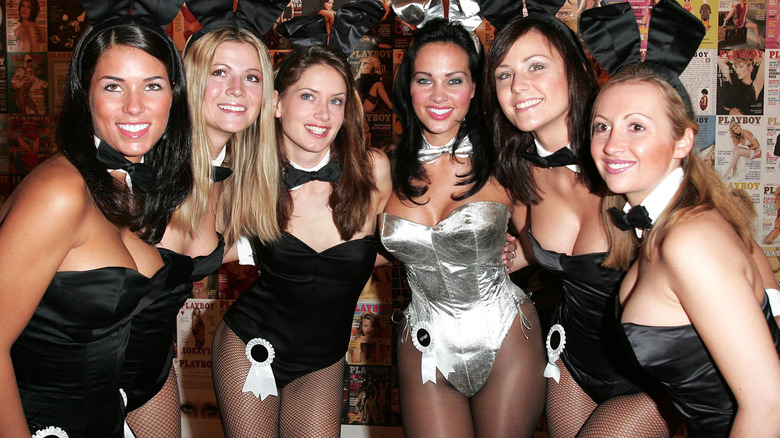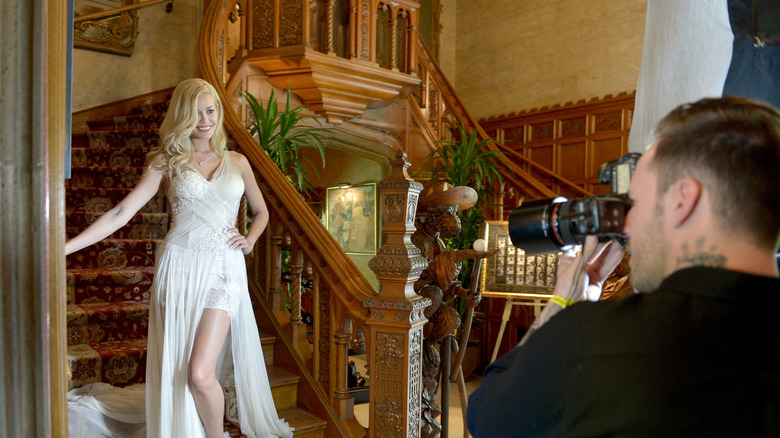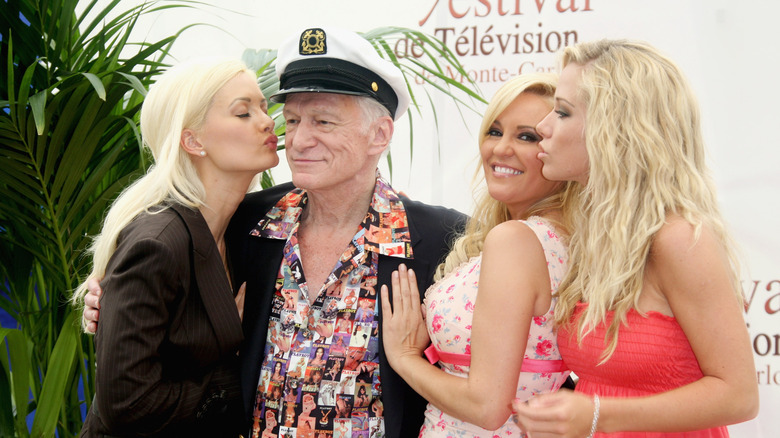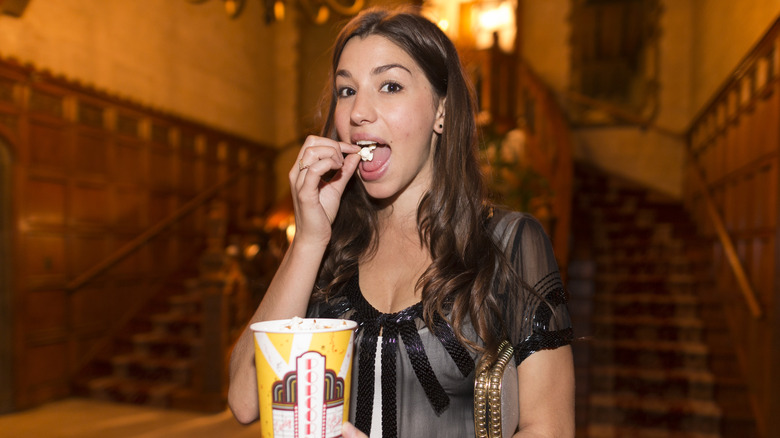The Worst Things Former Playmates Have Said About The Playboy Mansion
It might be hard to believe today, but there was a time when Playboy was a brand that represented elegant hedonism, a sort of intellectual bachelor lifestyle. Playboy not only offered photos of nude women, but it also published fiction and journalism by some of the best writers working. At its height, Playboy was a premium brand, an empire that featured its legendary magazine, television shows, a chain of nightclubs—and the iconic Playboy Mansion.
According to HGTV, Hugh Hefner bought the 22,000 square foot mansion in 1971. The mansion became part of Playboy's brand identity and marketing thanks to the frequent lavish parties Hefner hosted there. The parties attracted celebrities and were populated by current and former "playmates," the models who had posed for the magazine's infamous centerfolds. Fifty years later, the phrase "Playboy Mansion" still elicits mental images of wild parties where beautiful people have secret liaisons in the famous grotto.
But that was a triumph of marketing and far from reality. In truth, life at the Playboy Mansion wasn't a nonstop party and living there as a Playboy "Bunny" wasn't always fun, especially as Hefner aged into his 70s and 80s and continued to cavort with young women who were essentially his paid escorts. And the mansion itself wasn't very mansion-like. In fact, according to the playmates who actually lived there over the years, the place was something of a grim, depressing dump. Here are the worst things former playmates have said about the Playboy Mansion.
The place was a toilet for dogs
Mansions are just really big houses. And like all houses, they have to be maintained—repaired, occasionally remodeled, and cleaned. Especially cleaned, since we're talking about tens of thousands of square feet. And a mansion like the Playboy Mansion with a constantly-rotating population and frequent large parties probably needs to be cleaned more often than most. But it wasn't, according to playmates who lived there. Which led to a huge problem because people kept bringing their dogs to live with them. Their un-housebroken dogs.
In her book "Bunny Tales," playmate Izabella St. James notes that while she lived there, the house dog, Archie, regularly urinated on curtains in the mansion's hallway, "adding the scent of urine to the general scent of decay." And Curbed quotes St. James as complaining that fellow playmate Holly Madison's dogs weren't house-trained, and would constantly poop on the carpet in Hefner's bedroom—meaning every time you walked into the room you had to navigate a minefield of "dog mess."
St. James goes on to note that she and her fellow playmates convinced Hefner to put new carpeting in their own bedrooms, but he insisted on white carpets. Thanks to the dog situation, those carpets were "gray and stained in a matter of three months." And Hefner refused to let them replace it again.
The bedding was old and stained
The popular image of the Playboy Mansion—like most houses with the word "mansion" in their official name—was one of elevated living. If you tell people you're going to be sleeping in a mansion later on tonight, people naturally assume you'll be ensconced in 1,000-thread sheets and pillows stuffed with exotic feathers. But the truth was something altogether different—and kind of depressing.
In her book "Bunny Tales," playmate Izabella St. James says that the mattresses in the rooms given to playmates were old—she describes them as "worn and stained" and uses the word "disgusting" to describe the experience of sleeping on them. She also says that the sheets on the beds when she arrived were used, which isn't exactly what you expect when you move into a mansion that would eventually sell for $100 million.
St. James and her fellow playmates begged Hefner for some money to replace the bedding, and he relented—but forced them to account for every penny spent with receipts. Of course, this mattress situation is still better than the other mattress scenarios at the mansion, according to NPR, which include "napping" mattresses that were clearly intended for uses other than napping—and an entire room whose floor was just mattresses, which is just disturbing.
It's possible the Playboy Mansion was haunted
As anyone who's seen "The Haunting of Hill House" knows, an old mansion is a recipe for a haunting. And the Playboy Mansion is old. The Los Angeles Times reports that it was originally built in 1927 by Arthur Letts, Jr., heir to a department store fortune. So it was already close to 50 years old when Hugh Hefner bought it in 1971, and is fast approaching its 100th birthday.
So it's no surprise that several former playmates have described the place as definitely, absolute haunted. Nylon reports that playmate Bridget Marquardt observed plenty of supernatural happenings, including televisions randomly switching channels. She also straight-up saw a ghost, describing seeing a phantom woman standing in her closet doorway. Marquardt described the ghost as having "long, black stringy hair, very pale, very thin. She was wearing a white T-shirt that was too big on her and black acid wash-y jeans." Marquardt felt like she recognized the woman, but couldn't place her.
According to E! Online, playmate Holly Madison also saw evidence of a haunting, describing an encounter in the mansion's gym when a woman walked from the bathroom to a stairway—and vanished. And House Digest notes that Madison also claims the toilets often flushed themselves. The evidence seems clear: The Playboy Mansion is totally haunted.
Hugh Hefner never changed any of the décor
You might think that a huge mansion owned by a notorious millionaire, er, playboy would be the height of cutting-edge interior design. You would be wrong. Hugh Hefner bought the Playboy Mansion in 1971, when fashion and design trends were straddling the trippy 1960s aesthetic and the loud, wide looks of the 1970s. Just looking at Hefner's outfit in this article from The Hollywood Reporter tells you all you need to know about the design decisions that went into the mansion.
And according to playmates who lived there, Hefner never modernized after that, and the place was dangerously dated. Worse, Hefner resisted any suggestions that he redecorate to bring the place into the modern day. Forbes reports that former playmate Carla Howe once said that Hefner "refuses to change anything in the mansion" and that the whole vibe of the place felt like it was "stuck in the 1980s." And in her book "Bunny Tales," playmate Izabella St. James describes the furniture in her room as "old and damaged" and the overall aesthetic of the mansion as "old and stale."
It's not a surprise then that according to The Wall Street Journal when listing the property for sale in 2016, the real estate agent stated flatly that the house would need remodeling because the home interiors were "dated."
Living at the Playboy Mansion was like 'being in prison'
Hugh Hefner was in many ways a master marketer above all else. He crafted an image for the Playboy brand that evoked opulence, leisure, and sex appeal all at once. The Playmates were a key part of that image—beautiful women who posed provocatively and apparently lived jet-setting lives of parties, appearances, and living in the storied Playboy Mansion.
The reality wasn't nearly as fun, according to some of the women who actually lived there. Holly Madison wrote in her book "Down the Rabbit Hole" that she felt like the famous metal gate of the compound wasn't meant to keep people out—but to lock her in. US Weekly reports that fellow playmate Carla Howe explained why some playmates felt that way: a strict and surprisingly early curfew of 9 P.M.—not exactly the crazy partying lifestyle people imagine for playmates. In fact, Howe described her time at the mansion as "like being in prison."
Playmate Izabella St. James writes in her book "Bunny Tales" that the curfew and the restrictive lifestyle definitely took their toll on the girls, saying that she and the others felt "trapped most of the time" and that her experience at the mansion became a grind of "boredom and fatigue."
The place didn't smell good
When former playmate Izabella St. James describes the Playboy Mansion in her book "Bunny Tales" by saying it "was sexually liberating" and "the air smells like sex," that's probably within your expectations. After all, the Playboy Mansion was part of Hugh Hefner's media empire, which was 100% built on sex and the concept of sexual liberation.
But St. James goes on to note that after staying there for a while, she realized the air didn't smell like sex, it smelled like dog urine due to the number of dogs in the place who weren't housebroken. And St. James isn't alone. According to Radar, former playmate Carla Howe described the whole mansion as smelling damp, and when Kendra Wilkinson appeared on the Hollywood Raw Podcast, she noted that the smell of dog poop was "definitely stuck to the walls" of the place.
This was confirmed when Vice writer Jamie Lee Curtis Taete visited the mansion in 2013 for a movie screening. Taete wrote that the entire experience was "depressing" and concluded by noting that the mansion "smelled like old man." Which is mean, but also right in line with what the former playmates have said about the smell of the place.
The food was terrible
You might think that one of the perks of living in a mansion with its own kitchen staff and servants would be the food. After all, rich folks can afford the best of everything and can afford to pay people to bring you that best of everything any time you want it.
And indeed, former playmate Izabella St. James notes in her book "Bunny Tales" that the 24-hour kitchen at the Playboy Mansion was a big plus (and also a minus because the playmates gained weight). She loved the ability to order nachos or cheeseburgers after a late night out partying. St. James also notes that the kitchen at the Playboy Mansion did all the catering at events held there. According to Fortune, Hefner at one point was spending $46,000 a month on food alone, which supports the idea that the menu at the Playboy Mansion must have been pretty great.
But St. James's opinion of the food wasn't universal. Radar reports that former playmate Carla Howe described the fare served at the Playboy Mansion as "hospital food." The bad food might have had something to do with Hefner's personal diet, which US Weekly reports included 35-40 Pepsis a day, along with two or three pounds of M&Ms. Which begs the question of how he made it to such an advanced age.
The climate at the Playboy Mansion was toxic
The Playboy corporation took pains to present life in the Playboy Mansion as an erotically-charged fantasy. People were invited to imagine beautiful, scantily-clad playmates traipsing about having pillow fights, spontaneous orgies, and other good, clean fun. After all, life in a mansion means servants and luxury, and for playmates, there were endless parties and the promise of fame and fortune.
But according to some of those playmates, the atmosphere inside the mansion was anything but fun. In fact, in her book "Down the Rabbit Hole" Holly Madison says the "climate inside the mansion was toxic." The other playmates regularly engaged in drug binges, had secret boyfriends, violated their curfews, and resented Madison's rule-following, leading her to imagine they wouldn't shed a tear if she died. British GQ reports that the other playmates even stole Madison's clothes in a fit of mean girl energy.
Playmate Izabella St. James confirms the bad atmosphere in her book "Bunny Tales." She notes that Hefner would often distribute drugs to the playmates, who would combine them with alcohol—a combination she also describes as "toxic." Things got so bad inside the mansion that Madison writes she started to think that drowning herself was the only "logical" way to escape.
There were cameras watching your every move
For decades people imagined the Playboy Mansion was a monument to hedonism. The parties there must have been legendary, with beautiful playmates, famous celebrities, and personalities of all types cutting loose amidst luxurious surroundings—there's a very good reason everyone has heard about the infamous grotto, a perfect place for secret rendezvous.
But as noted by The New York Times, those parties could get a bit dark as drugs and alcohol drove people to give in to their worst impulses. This could be problematic because several playmates have noted that there's no such thing as privacy at the mansion—because it's littered with surveillance cameras. The Daily Mail reports that former playmate Jill Ann Spaulding confirmed hidden cameras were installed in the mansion by Hefner to inure himself from lawsuits. She says that when she arrived at the mansion in 2001, the other girls took her aside and warned her that there were cameras in most of the rooms. And US Weekly notes that Hugh Hefner's longtime valet confirmed this, noting that his employer constantly watched the playmates and guests via this surveillance system.
Worse, Newsweek reported on an allegation that Hefner would use these videos to blackmail his guests, including journalists.
It was 'cult-like'
To the outside world, the decision to become a Playboy Playmate seemed pretty straightforward. The gig involved professional modeling, being associated with a global brand, and the opportunity to live in an opulent mansion and live a jet-setting party lifestyle—all while being paid.
But according to former playmate Holly Madison, life inside the mansion was more like being in a cult. Insider reports that Madison says that the playmates living in the mansion were "all kind of gaslit" and tricked into believing Hugh Hefner was a nice man. She also notes that many other aspects of life inside the mansion are similar to the classic traits of cults: The girls were isolated from the outside world and their families, and contact with friends was discouraged. The playmates weren't even supposed to leave the grounds unless they were going to an official Playboy event.
And as noted by Newsweek, Madison also describes her relationship with Hefner in cult-like terms, claiming she experienced something closer to Stockholm Syndrome—when captives begin to psychologically identify with their captors—than a real relationship. And US Weekly reports that former playmate Sondra Theodore echoed the cult atmosphere, comparing Hefner to Charles Manson. Another former playmate, Miki Garcia, claimed that the women living in the mansion were "groomed" to believe they were part of Hefner's family—and that Hefner regarded the women as his property.
Hugh Hefner recorded without consent
It's no surprise that Hugh Hefner was enthusiastic about sex. The man built a media empire capitalizing on men's hidden (and not-so-hidden) desires. And the Playboy Mansion was the setting for frequent parties that focused on Hefner's stable of models he not-so-subtly called "playmates." But most people imagined that no matter how dirty things might get at the mansion, they were consensual.
But according to former playmate Sondra Theodore, that wasn't the case. As reported by People, Theodore says that Hefner recorded many of the women secretly, and without their consent. Theodore says during some of her bedroom encounters with Hefner, she was shocked to find cameras running. Worse, when asked to turn off the cameras Hefner would claim he had done so—but wouldn't actually stop recording. A few days later, the existence of a tape would be confirmed.
Best Life reports that this practice wasn't limited to video. Former playmate Holly Madison says Hefner also liked to take photographs of the girls—especially when they were "wasted out of their minds." In fact, Madison says that one reason she felt trapped in the mansion was her fear that if she did so Hefner would release some of the explicit photos he had of her. And Newsweek reports that many people believe Hefner used tapes like these to blackmail people into doing his bidding.
The Playboy Mansion was a lonely place
It's easy to imagine that being a celebrity at any level is pretty cool. The playmates living in the Playboy Mansion might not have been household names, but they were famous within their milieu, and when Playboy branched into reality TV with "The Girls Next Door" several of the models, like Holly Madison and Kendra Wilkinson, did become legitimately famous.
But according to former playmates, instead of being surrounded by friends, life in the Playboy Mansion was crushingly lonely. US Weekly reports that former playmate Carla Howe described life in the mansion as being "imprisoned," and Best Life notes that Holly Madison claims she was discouraged from having friends over.
Much of the loneliness stemmed from the strict 9 P.M. curfew—Radar notes that playmate Crystal Harris (and the eventual third and final Mrs. Hefner) said, "It was a little bit lonely in the Mansion. I couldn't go anywhere." In her book "Sliding into Home," Kendra Wilkinson describes coming back to the mansion by herself due to the curfew and receiving texts from her friends as they partied the night away. And Cosmopolitan notes that Karissa and Kristina Shannon, twin sisters and former playmates, moved out of the mansion because they weren't allowed to have boys over for visits. As glamorous as it might have seemed, life in the Playboy Mansion sounds pretty sad—and very lonely.
